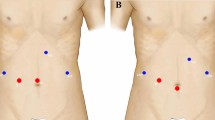Abstract
Despite the popularity of minimally invasive surgery (MIS) for hepatectomy, limitations in the approach of the right posterior section of the liver remain. Although skills and approach techniques have been developed for hepatectomy of lesions in the posterior segments of the liver, most are performed laparoscopically and are limited to few experienced hands using rigid laparoscopic instruments. In this study, we tried a different approach area via the aid of a flexible robotic system. Since 2012, we have successfully completed more than 200 robotic hepatectomy procedures in our institution. Two different patient settings have been applied for right posterior segment lesions, including supine position as general setting in early cases and left semi-lateral decubitus setting in our later cases. The demographic data and perioperative outcomes between the two groups were analyzed in regard to different positioning. A total of 25 patients with right posterior segment lesions underwent robotic-assisted resection, 13 were placed in supine position and 12 in left semi-lateral position. The left semi-lateral group had significantly shorter operation time (306.0 versus 416.8 min, p = 0.023), less blood loss (203.9 versus 1092.3 mL, p = 0.030), and lower transfusion rates (0 versus 46.2%, p = 0.015). We described an evolutionary technique for robotic right posterior segmentectomies with the patient placed in left semi-lateral position. This method can be applied for most patients easily and is demonstrated as a safe and feasible approach in selected patients owing to its ability to overcome the difficulty of MIS hepatectomy for right posterior lesions.


Similar content being viewed by others
References
Ho CM et al (2013) Systematic review of robotic liver resection. Surg Endosc 27(3):732–739
Yoon YS et al (2010) Total laparoscopic liver resection for hepatocellular carcinoma located in all segments of the liver. Surg Endosc 24(7):1630–1637
Hart ME, Precht A (2013) Robotic liver resection technique. Cancer J 19(2):147–150
Nguyen KT, Gamblin TC, Geller DA (2009) World review of laparoscopic liver resection—2,804 patients. Ann Surg 250(5):831–841
Rowe AJ et al (2009) Perioperative analysis of laparoscopic versus open liver resection. Surg Endosc 23(6):1198–1203
Qiu J, Chen S, Chengyou D (2016) A systematic review of robotic-assisted liver resection and meta-analysis of robotic versus laparoscopic hepatectomy for hepatic neoplasms. Surg Endosc 30(3):862–875
Buell JF et al (2009) The international position on laparoscopic liver surgery: the Louisville Statement, 2008. Ann Surg 250(5):825–830
Cherqui D (2003) Laparoscopic liver resection. Br J Surg 90(6):644–646
Casciola L et al (2011) Robot-assisted parenchymal-sparing liver surgery including lesions located in the posterosuperior segments. Surg Endosc 25(12):3815–3824
Cho JY et al (2009) Outcomes of laparoscopic liver resection for lesions located in the right side of the liver. Arch Surg 144(1):25–29
Yoon YS et al (2006) Total laparoscopic right posterior sectionectomy for hepatocellular carcinoma. J Laparoendosc Adv Surg Tech A 16(3):274–277
Cho JY et al (2008) Feasibility of laparoscopic liver resection for tumors located in the posterosuperior segments of the liver, with a special reference to overcoming current limitations on tumor location. Surgery 144(1):32–38
Tomishige H et al (2013) Caudal approach to pure laparoscopic posterior sectionectomy under the laparoscopy-specific view. World J Gastrointest Surg 5(6):173–177
Ikeda T et al (2014) Laparoscopic liver resection in the semiprone position for tumors in the anterosuperior and posterior segments, using a novel dual-handling technique and bipolar irrigation system. Surg Endosc 28(8):2484–2492
Murakami M, Aoki T, Kato T (2011) Video-assisted thoracoscopic surgery: hepatectomy for liver neoplasm. World J Surg 35(5):1050–1054
Leung U, Fong Y (2014) Robotic liver surgery. Hepatobiliary Surg Nutr 3(5):288–294
Wu YM et al (2014) Robotic-assisted minimally invasive liver resection. Asian J Surg 37(2):53–57
Strasberg SM (2005) Nomenclature of hepatic anatomy and resections: a review of the Brisbane 2000 system. J Hepatobiliary Pancreat Surg 12(5):351–355
Chen PD et al (2016) Robotic liver donor right hepatectomy - a pure, minimally invasive approach. Liver Transpl 22:1509–1518
Mostaedi R et al (2012) Laparoscopic liver resection: current role and limitations. World J Gastrointest Oncol 4(8):187–192
Choi GH et al (2012) Robotic liver resection: technique and results of 30 consecutive procedures. Surg Endosc 26(8):2247–2258
Giulianotti PC et al (2011) Robotic liver surgery: results for 70 resections. Surgery 149(1):29–39
Yu YD et al (2014) Robotic versus laparoscopic liver resection: a comparative study from a single center. Langenbecks Arch Surg 399(8):1039–1045
Ocuin LM, Tsung A (2015) Robotic liver resection for malignancy: current status, oncologic outcomes, comparison to laparoscopy, and future applications. J Surg Oncol 112(3):295–301
Tsung A et al (2014) Robotic versus laparoscopic hepatectomy: a matched comparison. Ann Surg 259(3):549–555
Tranchart H et al (2014) Traditional versus robot-assisted full laparoscopic liver resection: a matched-pair comparative study. World J Surg 38(11):2904–2909
Boggi U et al (2009) Robotic suture of a large caval injury caused by endo-GIA stapler malfunction during laparoscopic wedge resection of liver segments VII and VIII en-bloc with the right hepatic vein. Minim Invasive Ther Allied Technol 18(5):306–310
Cho JY et al (2008) Experiences of laparoscopic liver resection including lesions in the posterosuperior segments of the liver. Surg Endosc 22(11):2344–2349
Ikeda T et al (2013) Pure laparoscopic hepatectomy in semiprone position for right hepatic major resection. J Hepatobiliary Pancreat Sci 20(2):145–150
Clavien PA et al (2009) The Clavien-Dindo classification of surgical complications: five-year experience. Ann Surg 250(2):187–196
Author information
Authors and Affiliations
Corresponding author
Ethics declarations
Conflict of interest
Chao-Ying Wu, Po-Da Chen, Chih-Yuan Lee, Jin-Tung Liang, and Yao-Ming Wu declare that they have no conflict of interest.
Ethical standards
All procedures followed were in accordance with the ethical standards of the responsible committee on human experimentation (institutional and national) and with the Helsinki Declaration of 1975, as revised in 2000 (5). Informed consent was obtained from all patients for being included in the study.
Rights and permissions
About this article
Cite this article
Wu, CY., Chen, PD., Lee, CY. et al. Robotic-assisted right posterior segmentectomies for liver lesions: single-center experience of an evolutional method in left semi-lateral position. J Robotic Surg 13, 231–237 (2019). https://doi.org/10.1007/s11701-018-0842-1
Received:
Accepted:
Published:
Issue Date:
DOI: https://doi.org/10.1007/s11701-018-0842-1




